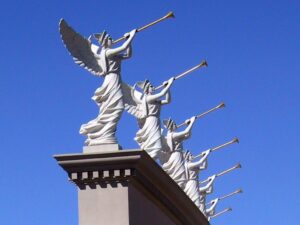
Previously, the Seven Seals revealed the just retribution of God against the outright enemies of His Church. This next chain of prophetic judgments, The Seven Trumpets, reveal God’s wrath upon the enemies within the church.
Once the former enemies were overthrown during the Constantine dynasty, God’s faithful were free to come out of hiding and publicly profess & practice their faith to recover and flourish throughout the Roman Empire and spread out among surrounding nations. However, this prosperity also gave way to many forms of corruption.
While the Christians before had everything in this world to lose, then they had so much to gain as Christianity was elevated to a prominent social status. Many people of lesser devotion came into the faith bringing with them mixed motives, worldly ambitions, and pagan traditions.
“By this gospel you are saved if you hold fast to the word I proclaimed to you – unless you believed in vain.” ~ 1 Cor 15:2
This newfound Christian society at a large scale, being wed to the state and Roman culture, had convoluted Christianity with many who were bearing the name of Christ in vain. Such mixture of those of genuine faith with those of empty faith becomes the typical tendency of any mass movement. Jesus prophesied of this condition in the parable of the wheat & tares (Mat 13:24-30). Thus many nominal believers and false converts flooded into the Church with various hypocrisies, heresies, and blending pagan tradition with the Christian faith.
The very essence of a holy people is a people set apart from the corruption of the world for service to God. Never had selfish ambition & pagan idolatry been tolerated within God’s assembly without consequences. Such immoral elements were the cause of God’s judgment upon His people Israel in the past, just as it was then the cause of judgment upon Christendom – via The Seven Trumpets.
Recognizing this clarifies what was meant by the startling action witnessed by St John of the heavenly scene where the angel took fire from the incense alter and cast it to the earth (Rev 8:5). There from the heavenly sanctuary, the very place of safety, came the wrath of God upon those who misused & abused the earthly sanctuary of God’s living Church. Hence, the angels poise for the seven trumpets.
“So the seven angel’s who had the seven trumpets prepared themselves to sound.” ~ Rev 8:6
Understanding what is meant by the sound of the trumpet is essential to understanding what is meant by this segment of prophesy. We must remember the Spirit of prophesy spoke to the Hebrew prophets in their own language (Acts 26:14), so sacred scripture is written from an Eastern/Jewish perspective, and though the New Testament was written in Greek, the writers were Jewish, who employed Jewish language patterns, idioms, philosophies, and references to religious rites. Anyone familiar with these knows full well the trumpet sound is the alarm of war.
“… I cannot hold my peace, because you have heard, O my soul, the sound of the trumpet, the alarm of war. Destruction upon destruction is cried, for the whole land is plundered. Suddenly my tents are plundered, and my curtains in a moment. How long will I see the standard (war icon), and hear the sound of the trumpet?” ~ Jeremiah 4:19-20
First Trumpet: Hail, Fire & Blood
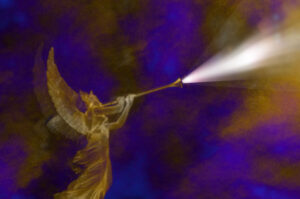
“The angel sounded: And hail and fire followed, mingled with blood, and they were thrown to the earth. And a third of the trees were burned up, and all green grass was burned up.” ~ Rev 8:7
Similar imagery of a ravaging storm was used in the oracles of God’s judgment upon His people Israel in Isaiah 28:2
“Behold, the LORD has a strong and mighty one, like a tempest of hail and a destroying storm. Like a flood of mighty waters overflowing, Who will bring them down to the earth with His hand.”
Also in Isaiah 29:6 the same with the element of fire, and Ezekiel 13:13, God says,“In My wrath I will release a windstorm, and in My anger, torrents of rain and hail will fall with destructive fury.”
This is a prophetic way of describing how God raises up foreign nations as a rod of justice upon the crimes of those who pervert justice. Accordingly, the trumpet sound is most fitting to signify the coming calamities of foreign invasions upon the “Christian Roman Empire”.
“…And a third of the trees were burned up, and all green grass was burned up.”
Again, understanding Jewish prophesy language is essential to understand what is meant by trees and grass. This is an illustrative way of referring to people of high stature (trees), and people of lower stature or common folk (grass). Such illustrations were often used in a positive sense for God’s faithful ones (Psalm 1:3, Jer 17:8), and applied in the negative sense to God’s enemies. See how such exalted ones are treated here in Isaiah 2:12-13:
“For the day of the LORD of hosts shall come upon everything proud and lofty, upon everything lifted up –and it shall be brought low –upon all the Cedars of Lebanon that are high and lifted up, and upon all the Oaks of Bashan”
Isaiah 10:33-34, speaking of the mighty Assyrians, “…Those of high stature will be hewn down, and the haughty ones will be humbled. He will cut down the forest thickets with iron…” In Zechariah 11:2 and Psalm 29:5 the same illustration of trees being likened to exalted figures who are doomed at the prospect of God’s wrath. Also, the same genre was so expressly clarified by Daniel’s interpretation of Nebuchadnezzar’s dream of the great tree which was cut down – Dan 4:10-36.
As for ‘grass’ – this illustrates the multitudes of common folk, which is used in Job 5:25, “You shall know that your descendants shall be many, and your offspring like the grass of the earth.” ; And 2 Kings 19:26. Grass is also used to describe young ones, as even our own English language uses this figure of speech when describing one who is young and inexperienced as ‘green’.
Now that we’ve defined certain key words and figures of speech within this prophetic phraseology of the first trumpet, let us remember where we are at in this point in history when such devastating judgment is so fitting. The general masses among the Christianized Roman Empire had brought in various corruptions into God’s holy assembly, making such hypocrisies & heresies the cause of God’s wrath.
This leads us to observe the catastrophic invasions from the hordes of foreign nations such as the Franks, Almans, Saxons, Quades, Sarmatians, and Persians. With much greater success than ever before, these invasions unleashed the fury of a violent storm so fitting to the prophetic imagery of hail and fire mingled with blood.
The devastating impact of this onslaught ran through both the eastern and western Empire. These advances started in the latter half of the fourth century for a few decades then settled down for a time by the strength of Emperor Theodosius.
Such calamities were cited by historians such as Zosimus, Claudian, and Eutropius. Philostorgius, who lived in that time, wrote of these horrors in poetic style so resembling the first trumpet oracle, “The sword of the barbarians destroyed the greatest multitude of men; and among other calamities, dry heats with flashes of flame and whirlwinds of fire occasioned intolerable terrors; yea, and hail greater than can be held in a man’s hand fell down in several places.”
Jerome cites, “they came unexpectedly everywhere, and quicker than report, spared not religion, nor dignitaries, nor age, nor had compassion on crying infants; Those were compelled to die who had not yet begun to live.” How so were a third of the trees burned up, and all green grass. Such indiscriminate cruelty & savagery of the barbarian people is no doubt why our English language adopted the word barbaric to describe such brutal & savage things. Alas, this is only the first wave of war…
Second Trumpet: A Burning Mountain
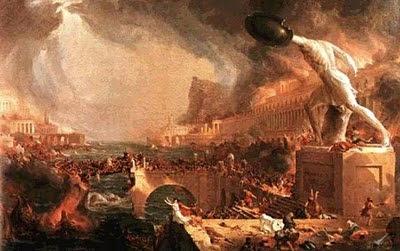
Then the second angel sounded: And something like a great mountain burning with fire was thrown into the sea, and a third of the sea became blood. And a third of the living creatures in the sea died, and a third of the ships were destroyed. ~ Rev 8:8-9
One again, we need to define certain words & phrases here by referring to Jewish prophesy language. First let’s look at a prophetic figure of speech which gives a clue to what the burning mountain may be:
In the oracle of Jeremiah 51:25, the Babylonian Empire was described as a destroying mountain, and its fall rendered as a burnt mountain:
“Behold, I am against you, O destroying mountain, who destroys all the earth,” says the LORD. “And I will stretch out My hand against you, roll you down from the rocks, and make you a burnt mountain.”
Zechariah 4:7 and Psalm 46:2 also render the same imagery of a toppling mountain to illustrate the impact of a powerful entity being cast down by divine providence. We have also many references to the Kingdom of God rendered as the mountain of the LORD: Isaiah 30:29, 25:6-10, 56:7, 57:13, Dan 2, and many more.
Now since the premise of these trumpet judgments of the Revelation is fixed on the Roman World, it would be reasonable to apply the burning mountain to the Roman Powers and the sea it was thrown into represents the multitudes of various people and nations of its metropolitan empire. See Revelation 17:15 – “And he (the angel) said to me, ‘The waters which you saw, where the whore sits, are peoples, and multitudes, and nations, and tongues’.”
The rest of the second trumpet reads, “… and a third of the sea became blood, and a third of the living creatures in the sea died, and a third of the ships destroyed.” ~ Rev 8:9
We must have a reckoning with this repeating detail a third – since it refers to the affected portion of the first four trumpets. At that time, the known world had three main parts – Asia, Africa, and Europe; and since the Roman Empire was principally European, it was considered a third part of the world. Thus, a third part of the sea, that is the Roman world, was heavily impacted by the bloodshed & mayhem of war.
“…a third of the living creatures in the sea died… This says the same as the previous description, a third of the sea became blood, just in different words. Such practice of repeating the same concept in different words (synonymous parallelism) was a typical Hebrew literary device used to emphasize and confirm something of great significance. The oracle of Ezekiel 29 supports what is meant by the living creatures in the sea, as the inhabitants of the Egyptian Empire were likened to the living creatures of the Nile River, who would meet the same doom as their Pharaoh.
…and a third of the ships destroyed.” – Ships being prophetic emblems of commerce & military might, which signify the wealth and strength of such great empires. Besides the figurative fulfillment, this detail was literally fulfilled by the barbarians such as the Vandals & Alains, which circled around the Mediterranean coastline, including Spain & Africa, devastating the maritime provinces, so the wealth and naval power of the empire were almost entirely ruined.
God’s providential rod of wrath especially came by Alaric, king of the Goths. No sooner after Emperor Theodosius’ passing in 395, Alaric marches upon Greece, conquers Athens, Corinth, Magara, Argos, and Sparta – destroys the cities, decimates the country, kills all males of age, and leaves the women & children, and all the riches to be plundered by his army. In the same ravaging manner, Alaric did likewise throughout Italy and sacked Rome by 410.
Third Trumpet: Waters Become Wormwood
 “Then the third angel sounded: And a great star fell from heaven, burning like a torch, and it fell on a third of the rivers and on the springs of water. The name of the star is Wormwood. A third of the waters became wormwood, and many men died from the water, because it was made bitter.” ~ Rev 8:10-11
“Then the third angel sounded: And a great star fell from heaven, burning like a torch, and it fell on a third of the rivers and on the springs of water. The name of the star is Wormwood. A third of the waters became wormwood, and many men died from the water, because it was made bitter.” ~ Rev 8:10-11
Upon the sounding of the third trumpet, a great star fell from heaven… The prophetic use of the word star signifies eminent dignitaries, such as kings, priests, bishops, and also angels. Our own English language applies this symbolic language to various celebrities as stars. Let us consider just a few examples in prophesy:
Balaams oracle of the coming Messiah in Numbers 24:17 – “…a Star will come out of Jacob, a Sceptre shall rise out of Israel…”
Prophesy of the Temple Priests as ‘stars’ being struck down by Antiochus Epiphanes, the Greek King rendered as as a little horn – “…and it grew great, even to the host of heaven; and it cast down some of the host and of the stars to the ground, and stamped upon them…” ~ Daniel 8:10
The fall of Lucifer in Isaiah 14:12 – “…How you have fallen from heaven, O Morning Star, son of the dawn!…”
Morning Star may also be translated to Lucifer, and son of the dawn is another way of saying the same. Such star symbolism is used for other eminent heavenly beings as well – “…the morning stars sang together, and all the sons of God shouted for joy?” (Job 38:7). And Jesus Christ, being the ultimate Morning Star, says, “I am the Root and the Offspring of David, the Bright and Morning Star.” – Rev 22:16
So now we may easily get a basic sense of this great star symbol of this Third Trumpet, which signifies an eminent figure, and we are tipped off about the status of this great star with the tagline – fell from heaven – denoting an apostate status, which likely refers to not only heavenly apostates, but earthly as well.
The next element in the rendering of this great star which fell from heaven is how it was burning like a torch. Fire typically signifies the wrath of God, and the element of fire is rendered in the first three trumpets.
And it fell on a third of the rivers and on the springs of water. Illustrative descriptions of rivers and springs of water have been widely used as emblems of healing, refreshing and spiritual revival. The scriptures abound with this kind of metaphor, such as Isaiah 41:18:
“I will open rivers in desolate heights, and fountains in the midst of the valleys; I will make the desert a pool of water, and the dry land springs of water.”
Our Lord Jesus saying, “…the water I shall give him will become in him a fountain of water springing up into everlasting life.” ~ John 4:14
And St. John’s vision of eternity. “And he showed me a pure river of water of life, clear as crystal, proceeding from the throne of God and of the Lamb.” ~ Rev 22:1
Clearly the poetic use of rivers and springs of water communicates vitality of life, especially spiritual life. Unfortunately, in this oracle of the third trumpet, this symbol of life is contaminated by this falling star, and that contamination is better described in the next part of the passage:
The name of the star is Wormwood. A third of the waters became wormwood, and many men died from water, because it was made bitter. ~ Rev 8:11
Almost every learned interpreter I know of has surprisingly missed the significance of the meaning of wormwood, and how fitting it is to this prophesy within the context of its time & circumstances. Now western society understands wormwood to be a certain plant (Artemisia absinthium) of bitter taste which has medicinal qualities – not a bad thing. Yet from a Jewish perspective, wormwood is understood to be a plant more like Hemlock, which is fatally poisonous, and it also denotes to something quite scandalous. The very premise of this Jewish thought is found in Deuteronomy 29:18
“…that there may not be among you man or women or family or tribe, whose heart turns away today from the LORD our God, to go serve the gods of these nations, that there may not be among you a root bearing poisonous fruit and wormwood.”
Note the ‘poisonous fruit and wormwood’ is referring to idolatry within the assembly of God’s people (very important). Not only does idolatry among God’s congregation leave a bitter taste in God’s mouth, but infects God’s assembly like an invasive disease. Notice also how this warning addresses the element starting as a root, which is beneath the ground unbeknownst until it crops up with its poisonous fruit to infect the holy assembly of God.
This concept is the premise on which the Jewish idiom ‘gall of bitterness‘ is derived. It was a figure of speech used along with wormwood to illustrate idolatry among God’s house, and the malignant effects of its poisonous doctrines. This was precisely what Simon Peter was insinuating when confronting Simon the Magician in Acts 8:23 when saying, “I see a gall of bitterness and bonds of iniquity”, which was not just a confrontation of sin isolated to Simon, but a prophetic prediction which perceived something which was just the beginning of a widespread plague of poisonous doctrine coming down the pike.
And indeed it was, as so many of the apostolic fathers wrote about the troublesome legacy of Simon Magus, with his pagan-Christian hybrid, whose poisonous doctrines spread throughout the Roman world like a plague. Fortunately, the true saints of God did much to keep this root bearing poisonous fruit and wormwood in check during the early stage of the Church. As widespread & insidious as it was, the pseudo-apostles of the Simonean movement were still limited by the zeal of the true saints, as well as the general persecutions.
Yet once the persecutions were lifted at the time of Constantine, such poisonous doctrines were cropping up throughout the Christianized Roman Empire; And as we have already observed, such a deplorable element in the church, such a gall of bitterness and wormwood in God’s house, was the premise of these judgments of the seven trumpets, which is particularly expressed in this third trumpet as wormwood.
We saw in the past how God dealt with His people for idolatry – from the very first offense in the desert when young Israel fashioned a golden calf to worship and revel before; God then ordered the primary offenders to be slain, then burn & grind the golden calf to powder, and scatter on the water for the rest of the people to drink; God then followed up with a plague. ~ Exodus 32
Never had God tolerated this kind of offense among his congregation, saying through Jeremiah, “Behold, I will feed them, even this people, with wormwood, and give them water poisonous to drink.” (Jer 9:15). The basic sense of what is meant by the theme of wormwood is – if God’s people want to go off and worship false gods, then they shall drink of the poison cup of that bitter fruit.
So it was that God was then dealing with those of the Roman world, who were bearing His name, who had turned justice into gall, and the fruit of righteousness into wormwood!” (Amos 6:12 ). Thus, the same poison of wormwood which gave a bitter stigma to the holy name of the LORD and affected His church like a malignant disease, was given back to those to drink – who endorsed or tolerated those poisonous doctrines. Understanding the biblical meaning of wormwood is vital to recognize these trumpet judgments were directed towards those of God’s assembly who had brought idolatry into His holy congregation.
Genseric, king of the Vandals and Alans, was a staunch adherent of the Arian heresy, wreaked havoc throughout the Roman Empire, and cruelly persecuted the Orthodox Christians during the first half of the fifth century. The crescendo of his military campaign was the sack of Rome in 455, when he heavily plundered all domain, stripping out every valuable item from public buildings, private houses, and church buildings; then leaving with massive amounts of captives. Thus, Roman society was drinking the bitter poison of bondage and carnage, both physically and spiritually.
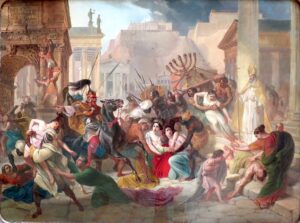
Several commentators have assigned king Genseric to that great star which fell from heaven, burning like a torch; Yet there was another ravaging figure who fell upon the Roman Empire during the same time, Attila the Hun. He and his forces had ravaged from east to west, decimating provinces and devastating cities – slaughtering, plundering, raping, and burning.
Genseric was an apostate and Attila was a foreigner – together representing the bitter poison of apostasy and foreign gods. Both figures collectively meet the criteria to represent heresy as well as God’s rod of reproof. Considering the overall sense of the meaning and application of this prophesy of the third trumpet is clear enough, after analyzing it as we have, that God had used such forces like Genseric and Attila to reprimand those bearing His name.
Fourth Trumpet: The Great Lights are Struck
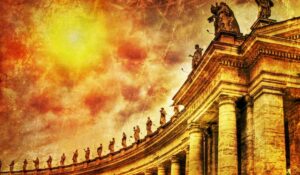
Here is another vision rendering an illustration of cosmic disturbances often used by the Spirit of prophesy. We already observed such a design of ‘cosmic cataclysm’ in the prior prophetic sequence of The Seven Seals, particularly the sixth seal. Just to quote one of many examples of the Hebrew prophets, Isaiah 13:10
“For the stars of heaven and their constellations will not give their light; The sun will be darkened in its going forth, and the moon will not cause its light to shine”
Others examples are found in Ezekiel 32:7-8, Isaiah 34:4, Joel 2:10 & 2:31, and Matt 24:29. Such a genre of cosmic imagery was a rather typical style among the prophets of Israel in foretelling the pending doom of worldly kingdoms in opposition to the Kingdom of God. All these have collectively established a prophetic pattern, as this particular model of ‘cosmic cataclysm’ always signifies the overthrow of a great kingdom.
With such a precedent to this genre of prophesy, which consistently carries on the same meaning, we can be sure this particular style of cosmic imagery was intended to predict the downfall of a great empire of the New Testament era; And following the prophetic sequence within historical chronology naturally brings us to the fall of the Western Roman Empire.
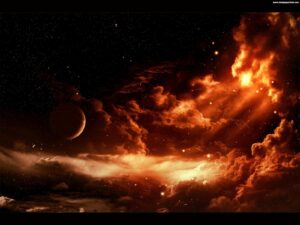 The event of a solar or lunar eclipse was considered by the Jews a bad omen, so as the oracle describes the sun, moon, and stars as being struck – this signifies something terrible. And as we had already examined, eminent ones such as rulers or religious dignitaries have been rendered as stars in prophesy style; Accordingly, the sun would be considered the most eminent, and the moon a reflection of that preeminence. Putting together all these components gives us a picture of an empire which is being struck down from the imperial head to the governing body.
The event of a solar or lunar eclipse was considered by the Jews a bad omen, so as the oracle describes the sun, moon, and stars as being struck – this signifies something terrible. And as we had already examined, eminent ones such as rulers or religious dignitaries have been rendered as stars in prophesy style; Accordingly, the sun would be considered the most eminent, and the moon a reflection of that preeminence. Putting together all these components gives us a picture of an empire which is being struck down from the imperial head to the governing body.
This figurative representation of the fourth trumpet renders a most fitting expression of the final & fatal blow to the western branch of the Roman Empire. The condition of the empire was already in dire straits from the previous waves of ravaging wars; During its final stage in the middle of the sixth century, Rome was miserably besieged and taken five times within a few decades. The imperial city as well as the whole country of Italy suffered greatly from these calamities of war, which reduced Rome to a most debased condition, effectively ending its imperial structure & status.
This phase began under the reign of Romulus Augustus, who was compelled by Odacer, king of the Heruli, to renounce his throne in 476. This event perfectly matches the illustration – a third of the sun was struck; As already observed, the Roman world, principally European, considered a third of the world, and the sun representing the preeminence of an emperor – was struck down, extinguishing the light of the imperial head. Yet the lesser lights, that is the Roman senate, consuls, and other subordinate magistrates, were allowed to continue for a time.
A series of successions of different kingdoms pulled Rome from one power to another like a ring of various predators ripping & pulling on the same kill. In 493, Theodoric, king of the Ostrogoths, founded his kingdom in Italy for about sixty years. Then the Ostrogoths were destroyed by the royal branch of the eastern Roman Empire (aka Byzantine Empire); Emperor Justinian then established a new government in Rome, the Exarch of Ravenna, reducing Rome to a mere dukedom, effectively ending Roman government. Thus, the lesser lights of Roman rule were extinguished – the senate, consuls, patricians and magistrates were struck down.
Such destruction of the Roman world came in an incremental process which corresponds with the Seven Trumpets. As brutal as these judgments may be, it was yet merciful of God to deliver justice one wave at a time, rather than wipe em all out in one stroke. This gave time for anyone inclined to come to their senses, and any who have an ear to listen, to act accordingly. It gave opportunity for God’s true saints to warn the Roman world, as well as flee to other countries to spread the gospel, as was the case.
After the fourth trumpet, the Apostle John then reveals, “And I looked, and I heard an angel flying through the midst of heaven, saying with a loud voice, ‘Woe, woe, woe to the inhabitants of the earth, because of the remaining blasts of the trumpets of the three angels who are about to sound!’” (Rev 8:13). This passage draws attention to an elevated degree of severity to come from the remaining trumpets. Thus, the three woes are assigned to the last three trumpets.
So far, the Roman Empire had been ravaged from east to west, with the western branch especially pounded to extinction. The royal court of the eastern branch, which became known as the Byzantine Empire, was spared from utter annihilation, though greatly reduced in strength. Remember, the premise of these divine judgments was due to the shameful representation of the Christian name, and since the western branch was most guilty, the west was struck down first, though the Latin-Roman church still remained.
The Eastern court was still allowed to exist because there was still enough vestige of true Christianity for a chance to clean up. Religious reforms and councils which affirmed sound doctrines of the faith were positive attributes of the Byzantine, and their preservation of the Greek New Testament manuscripts and Septuagint carried priceless value. Yet the pagan elements of Greek philosophy became amalgamated with Christian philosophy, and the servant leadership model of The New Testament was supplanted with a hierarchical leadership structure. Thus, the Christian model was being eclipsed by a worldly paradigm with veins of idolatry; So the next trumpets of divine judgment commence…
Fifth Trumpet: Locust Warriors from the Pit
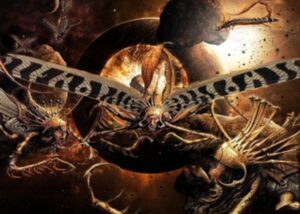
“Then the first angel sounded: And I saw a star fallen from heaven to the earth. To him was given the key to the bottomless pit. And he opened the bottomless pit, and smoke arose out of the pit like smoke of a great furnace. So the sun and the air were darkened because of the smoke of the pit.
Then out of the smoke locusts came upon the earth. And to them was given power, as the scorpions of the earth have power. They were commanded not to harm the grass of the earth, or any green thing, or any tree, but only those men who do not have the seal of God on their foreheads.
And they were not given authority to kill them, but to torment them for five months. Their torment was like the torment of a scorpion when it strikes a man. In those days, men will seek death and will not find it; they will desire to die, and death will flee from them.
The shape of the locusts was like horses prepared for battle. On their heads were crowns of something like gold, and their faces like the faces of men. They had hair like women’s hair, and their teeth like lions’ teeth. And they had breastplates like breastplates of iron, and the sound of their wings was like the sound of chariots with many horses running into battle.
They had tails like scorpions, and there were stings in their tails. Their power was to hurt men five months. And they had a king over them, the angel of the bottomless pit, whose name in Hebrew is Abaddon, but in Greek he has the name Apollyon.” ~ Rev 9:1-11
This is the most detailed prophesy so far, which helps to identify what the figurative rendering of the locusts warriors represent. The prior prophesy left off from the middle of the sixth century, so the detail of this fifth trumpet oracle may be found to correspond with the major event which erupted around the end of the sixth century.
First off, the prophesy renders another symbol of a star fallen from heaven to the earth. As already mentioned, a star symbolizes eminent figures, both good and evil as well as heavenly or earthly – so there is a wide application of various figures which could possibly be assigned to this symbol. Thus, various commentators have submitted diverse possibilities regarding the identity of this star – from Jesus to Satan.
It seems to me, since this figure is represented as fallen from heaven, that a righteous one from heaven or earth was not intended; Rather, the fallen aspect seems to give the sense of an apostate figure, one who has fallen from a position of righteousness, or one who providentially strikes apostate society. We will get back to this point once we have clarified the rest of the prophesy.
One thing for certain, this figure is an agent permitted by the providence of God, to loose the evil of this judgment – To him was given the key to the bottomless pit. And he opened the bottomless pit… The bottomless pit, also known as hell, hades, etc. indicates the great evil about to be unleashed.
…and smoke arose out of the pit like smoke of a great furnace. Billowing smoke signifies the loss of clarity …so the sun and the air were darkened because of the smoke of the pit. As we have observed, the lights of the sky, such as the moon and stars, represent eminent ones, the sun being the most eminent. And who’s eminence is greater than the preeminence of Jesus Christ – the light of the world?! Therefore, the light of the Gospel of Jesus Christ and His church (the air) was darkened by this corruption billowing from the bottomless pit, this being the beginning of what has been called the dark ages.
“Then out of the smoke came locusts upon the earth. And to them was given power, as the scorpions of the earth have power.”
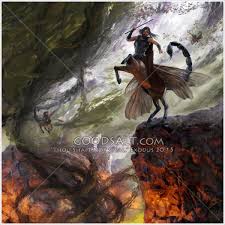
Now we get to the locusts, which have been misinterpreted as demons and such, but the scriptures, once again, give us clues to what is meant by the locusts. From the geographical perspective of Israel, locusts have been used as both a symbol and literal element of God’s judgment coming from the East:
“So Moses stretched out his rod over the land of Egypt, and the LORD brought an east wind on the land all that day and all night. When it was morning, the east wind brought the locusts…” ~ Exodus 10:13
Furthermore, invaders from the East have been likened to locusts, which make swift destruction with their multitudes:
“Now the Midianites and the Amalekites, all the people of the East, were lying in the valley as numerous as the locusts; and their camels were without number, as the sand of the seashore in multitude.” ~ Judges 7:12
And here in Nahum 3:15-17:
“There the fire will devour you. The sword will cut you down. It will eat you up like locust.
Multiply yourselves – like the locusts!
Multiply yourselves – like the swarming locusts!
You have multiplied your merchants more than the stars of heaven.
The locust plunders and flies away.”
Also, when God declares in Jeremiah 51:14: “Surely I will fill you with men, as with locusts, and they shall lift up a shout against you.”
A prominent theme in the writings of Joel is the invasion of foreign armies illustrated as devouring locusts in Joel 1:4-7 & 2 :25. Still there are other passages with the same genre, such as Judges 6: 5 and Jeremiah 46:23 , which collectively provides a precedent for this figurative expression of locusts being likened to the numerous invaders of the East. So it was, at that time around the beginning of the seventh century, Muhammad was uniting the Arab nations into one Muslim society which would take the world by storm.
Abul-Faraj, an Arabic historian, wrote of a natural phenomenon which rendered a literal fulfillment to the sun and the air being darkened, besides its figurative fulfillment: In the seventeenth year of Emperor Heraclius, and fifth year of Hegira, being 627, half the sun was eclipsed and the sky was darkened from October to June. This was the same time when Muhammud began his first raids and war campaign. Soon after, Arab Muslims, also known as Saracens, were invading the Roman world, which the Byzantine Empire was trying to hold together while exhausted from the Persian conflicts.
“And to them was given power, as the scorpions of the earth have power…” – They were empowered to effectively subdue the populace like the debilitating effect of a scorpion sting.
Who can deny the magnitude of impact from the Muslim conquests? Such a force came to permanently change the demographic landscape of Roman society as well as outer nations. While the Spirit of prophesy rendered their forces as locusts with scorpion stings, historians like Howard-Johnston likened them to a human tsunami, which overtook vast amounts of territories. The progress of these conquests was not like anything the Roman world had seen before.
The fifth trumpet oracle continues in detail: “They were commanded not to harm the grass of the earth, or any green thing, or any tree, but only those men who do not have the seal of God on their foreheads.”
We already observed how people of high stature have been likened to trees, and common folk like grass; Now this part of the prophesy confirms & clarifies what is meant by grass and trees, saying in the same sentence, “…but only those men who do not have the seal of God on their foreheads.” So what this means is – no person who is a true saint would be harmed by these invaders, neither those of high stature or low, but only those who are not truly Christian.
Accordingly, the general Roman populace was impacted by the Muslims, except in Savoy, Piedmont, and Southern France – which were the lands where the remnant of true Christians, known as the Waldensians and Albigenses, inhabited. It was Charles Martel who providentially turned the Muslims from these regions, effectively sanctifying these people from this divine fury.
Also, the Islamic war policy was more lenient on those they called people of the book, that is Jews & Christians – as compared to the nonnegotiable treatment to those they called Harbi, which refers to atheists or idolaters, including idolaters under the name of Christianity.
Besides the figurative fulfillment, this detail of the trees & grass was also literally fulfilled with the policy of the Muslim invaders. Rather than destroy the resources of those being conquered, as those invaders before did, the Arab Muslim strategy was to seize the resources for themselves. Caliph Abu Bakr gave orders to military leader, Yezid, “Destroy no palm trees, nor burn any fields of corn; cut down no fruit trees, nor do any mischief to cattle, only such as you eat.” Their speed on horseback could not be hampered with much supplies so they relied on food from the lands they invaded.
“And they were not given authority to kill them…” – Certainly, there was killing involved in these invasions, but high casualty rate was not their principal strategy.
“…but to torment them for five months…” – Their custom was to advance their war campaign during the warm season from April to September, that is five months. Arabs, not accustomed to cold, were inclined to retreat during the winter months. Likewise, natural locusts live only about five months, April to September, and scorpions are generally active during the same warm season before going dormant for winter.
“Their torment was like the torment of a scorpion when it strikes a man” – Again, the analogy of a scorpion sting, which is not only debilitating, but tormenting; Usually not fatal, but can make one so ill they wish they were dead. In the Hebrew language, scorpions is a symbol of punishment, whereas the scourges of the gruesome barbed whip is literally called scorpions just as its rendered in 2 Chron 10:11.
“In those days, men will seek death and will not find it; they will desire to die, and death will flee from them.” – The miseries of war were so tormenting that death was more favorable than falling into the hands of these ravaging invaders. Their military law gave license to take captives and rape women at a higher degree than prior invaders. Sex slaves were so tormented they would desire death, and conquered societies were generally subject to Muslim rule, with their foreign religion & customs imposed upon them.
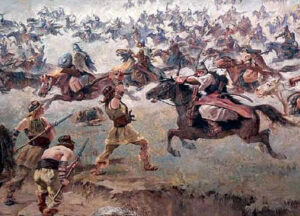 “The shape of the locusts was like horses prepared for battle…” – Arabians have always been renowned for their excellent horse breeds and horsemanship; thus their identity was intrinsically bound with their horses, being their distinguishing mode of war. It also must be noted how the Spirit of prophesy described, through Joel, the foreign invaders as devouring locusts which resembled horses, “Their appearance is like that of horses; And like war horses, so they run” ~ Joel 2:4
“The shape of the locusts was like horses prepared for battle…” – Arabians have always been renowned for their excellent horse breeds and horsemanship; thus their identity was intrinsically bound with their horses, being their distinguishing mode of war. It also must be noted how the Spirit of prophesy described, through Joel, the foreign invaders as devouring locusts which resembled horses, “Their appearance is like that of horses; And like war horses, so they run” ~ Joel 2:4
Back to the next detail of the fifth trumpet – “On their heads were crowns of something like gold…” – Crowns – representing the kingdoms & dominions they came to acquire from their conquests –“…and their faces like the faces of men…” – Faces like men – clarifies they were not literal locusts, or demons, but men. However, the bottomless pit indicates the evil spirits empowering them.
“They had hair like women’s hair…” – their custom was to wear long hair and beards – “…and their teeth like lions’ teeth…” – denoting their devouring nature. “And they had breastplates like breastplates of iron, and the sound of their wings was like the sound of chariots with many horses running into battle.” Certainly, they were well equipped with armor & cavalry, their primary asset being horses, which gave them speed as if they had wings. The general speed of their conquests is also quite remarkable.
“They had tails like scorpions, and there were stings in their tails.” – For the third time this detail of their scorpion-like sting is repeated to emphasize the tormenting pain of these ravaging hoards.
“Their power was to hurt men five months.” This duration of torment is repeated a second time; We had already observed the parallels between the natural locusts and the figurative locusts – being active during the spring-summer season, then retreating for winter. This parallel application seems to be the more natural interpretation, but there may be more to it than that:
It is possible that the Spirit of prophesy may have also intended the duration of five months to be prophetic months – according to the one day for a year principle we get from Ezekiel 4:6 & Numbers 14:34. That would amount to 150 years, which may be applied to the time in which the Muslims accomplished their primary conquests; From the time Muhammud began propagating his teachings in 612 – to the year 762, when Bagdad was built; their empire was then established. At that point, their rapid conquests had settled, and they functioned more like an ordinary nation.
Furthermore, the five months is repeated, so if we double the duration according to prophetic months, we then have 300 years; Quoting Sir Isaac Newton, “The whole time that the caliphs of the Saracens (Arabs) reigned with temporal dominion at Damascus and Bagdad together, was 300 years, from the year 637 to the year 936 inclusive.”
Before analyzing the concluding verse of this prophesy, let us reflect on how well the particular details of this fifth trumpet oracle aligns with the very distinguishing attributes of the Arab invaders. Such evidence is why there had been general consensus on this interpretation; even the more reserved scholars like Adam Clark had acknowledged how agreeable this illustration is to the Arab Muslims.
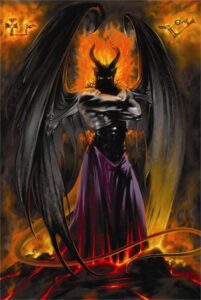 “And they had a king over them, the angel of the bottomless pit, whose name in Hebrew is Abaddon, but in Greek he has the name Apollyon.” – The Hebrew name Abaddon, or in Greek, Apollyon, means Destroyer. This concluding verse brings us back to the introductory element of the prophesy – the bottomless pit, which was illustrated as a star fallen from heaven to the earth. To him was given the key to the bottomless pit. And he opened the bottomless pit, and smoke arose out of the pit like smoke of a great furnace.”
“And they had a king over them, the angel of the bottomless pit, whose name in Hebrew is Abaddon, but in Greek he has the name Apollyon.” – The Hebrew name Abaddon, or in Greek, Apollyon, means Destroyer. This concluding verse brings us back to the introductory element of the prophesy – the bottomless pit, which was illustrated as a star fallen from heaven to the earth. To him was given the key to the bottomless pit. And he opened the bottomless pit, and smoke arose out of the pit like smoke of a great furnace.”
Notice the distinction between the star who opens the pit – and the angel who came out of the pit. This indicates that the star fallen from heaven and the angel, Destroyer, from the pit are not the same figure. As already mentioned, we cannot have certainty about the identity of these agents, as there are variable possibilities ranging from good to evil, or heavenly to earthly. However, the detail & context of the prophesy coupled with the context of history helps to provide a reasonable & educated inference…
Most scholars agree that the angel-destroyer from the bottomless pit, king of the locusts armies, likely represents Muhammud. Some suggest this angel is Satan, and both may very well be true as there may certainly be a spiritual agent like Satan or another rebel spirit in tandem with an earthly agent like Muhammud. Remember, for every earthly thing, there is a spiritual backdrop – for we wrestle not against flesh and blood, but against principalities, against powers, against the rulers of darkness of this age, against the spiritual hosts of wickedness in the heavenly realm (Eph 6:12).
Though it seems the angel released from the pit who empowered Muhammud would more likely be another spirit besides Satan, since it is questionable that Satan was locked up until then. However, the star fallen from heaven, who opens the pit, is more likely to be Satan since he, in his former state as Lucifer, is described as fallen from heaven, “…How you have fallen from heaven, O Lucifer” (Lucifer also translated as Morning Star – Isaiah 14:12); also Jesus said,“I saw Satan fall from heaven like lightning” (Luke 10:18); so there is a precedent for Satan/Lucifer described as an angel/star fallen from heaven.
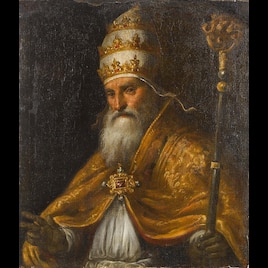 Such an icon of heavenly apostasy may very well have a human representation of apostasy on earth, which brings us back to the historical context of the seven trumpets. Remembering the premise of these trumpet judgments was because of the declining integrity of the Church from its brief glory during the Constantine dynasty. One of the chief elements among this corruption were the popes of Rome, which were emerging as a powerful force. The papal dynasty may very well be the earthly representation of a star fallen from heaven, as we remember that heaven may also be used as a symbol to illustrate the upper echelon of earthly dominion, and the “Holy See” of Rome was certainly the most eminent figure of that apostasy on earth.
Such an icon of heavenly apostasy may very well have a human representation of apostasy on earth, which brings us back to the historical context of the seven trumpets. Remembering the premise of these trumpet judgments was because of the declining integrity of the Church from its brief glory during the Constantine dynasty. One of the chief elements among this corruption were the popes of Rome, which were emerging as a powerful force. The papal dynasty may very well be the earthly representation of a star fallen from heaven, as we remember that heaven may also be used as a symbol to illustrate the upper echelon of earthly dominion, and the “Holy See” of Rome was certainly the most eminent figure of that apostasy on earth.
Some scholars such as John Gill agreed with this inference because it aligns with the circumstances better than any other figure. The following testimony from Alberto Rivera lends credence to this point as well:
According to the testimony of ex-Roman Catholic Jesuit Priest, Alberto Rivera, the popes & clergy of Rome were involved in a deep plot to raise up a force to seize control of Jerusalem. The Roman Catholic hierarchy had a burning aspiration to possess Jerusalem for its religious significance and strategic location. Ex-Jesuit, Alberto Rivera, testified of this highly guarded secret disclosed to him by Vatican Librarian, Cardinal Bea.
The plan was to groom a young man, with a charismatic persona to be a prophet, to unite the Arab nations into one religious polity. The religious fervor of such a union would compel such manpower with the energy it would take to accomplish the plan; A plan which also included the extinguishing of the Jews and true Christians who opposed the corruption of the Roman Church.
While various Catholic agents were manipulating Muhammud and propagating Islam, the Vatican helped finance the massive Islamic armies (…And to them was given power…). Such forces came together remarkably well, and the plan seemed to be succeeding – until it was time for the Muslims to hand over Jerusalem.
At that point, Islam had already been running with its own idea’s contrary to the Roman Church, and became a force beyond control, which caused a great schism between Islam & Rome. Islam came to view idolatry as an abomination to Allah, so instead of targeting the true Christians, they turned their fury principally upon the idolatrous ones, and the Roman Church was the most idolatrous of all; And as divine providence would have it: “They were commanded not to harm the grass of the earth, or any green thing, or any tree, but only those men who do not have the seal of God on their foreheads.”
This testimony of Alberto Rivera agrees perfectly with the detail of the fifth trumpet prophesy and its historical context. See the full testimony here. It reinforces the reasonable inference that the Roman Papacy may be the human representative of the star fallen from heaven as Lucifer may be the angelic side of that, which both served to unlock the bottomless pit to release the locust armies. The next segment of prophesy will reveal the true colors of popery as it rises to a most formidable world power.
I must say, if there is evidence to this testimony, it would be secured inside the Vatican Library, and the only witness we had to this story was ex-Jesuit, Alberto Rivera, who would have had access to that kind of information. Considering the gravity of such a scandal, which would greatly impact both Islam and Rome if fully exposed, it is not surprising that Alberto Rivera had been sharply discredited and eventually killed by the powers that be. Though you may see this article on Alberto, which substantiates his credibility.
Even if we leave out this testimony, the verifiable facts of this historical context are enough to reasonably infer that the Papacy represents the star fallen from heaven, which unlocked the bottomless pit to release the locust armies of Muhammud . Though I say it is wise to maintain reservation on this kind of detail, we should still remember that the corruption of idolatry in the church was the main cause of this divine judgment of the fifth trumpet.
“One woe is passed. Behold, still two more woes are coming after these things.” ~ Rev 9:12
Before covering the second woe of the sixth trumpet, there is something we must observe and clarify:
So far, this series of prophesy, from the Seven Seals into the Seven Trumpets, have chronologically fulfilled from the first century to the seventh, with a time span between each prophesy no more than about 50 years, and with some oracles overlapping. This orderly pattern of successive prophesies, each commencing its fulfillment shortly after the prior oracle, is a parameter which keeps us on a steady track to correctly interpret the progression of prophetic history. Adhering to this basic principle supports & clarifies each prophesy, which would be darkened & most questionable if any one oracle were pulled out of its chronological & historical context.
Unfortunately, many commentators have deviated from this basic principle upon arriving at the sixth trumpet. This is a very curious thing coming from scholars who have recognized the importance of this chronological pattern. Holding true to the pattern leads us to look to the latter part of the seventh century for the fulfillment of the sixth trumpet; However, a popular view of the sixth trumpet applies an event which happened in the 15th century – 800 years later! That is a huge breach between the fifth trumpet and the sixth, which completely departs from the chronological pattern of the average 50 year span.
This event of the 15th century, which had been applied to the sixth trumpet, was the Turkish invasions, which climaxed with the fall of Constantinople (Byzantine capital) in 1453. Admittedly, this view makes some points worth considering, such as the fire and the smoke and the brimstone which came out of their mouths, which is interpreted as canons, whereby the prophetic description also says, “their power is in their mouth and in their tails”, which is interpreted as the power of canon having the fuse & gunpowder pack at the rear while the canon ball shoots out the mouth. That is such a fascinating view that I almost want to believe it – but 800 years is much too far a stretch from the incremental sequence of the consistent prophetic pattern.
Moses Lowman is one of the few scholars who had ignored that popular view and stuck with the principle of looking for the succeeding prophesy to commence within a 50 year span. The correctness of looking to the latter part of the seventh century and into the beginning of the eighth century for the sixth trumpet fulfillment is further reinforced with the next segment of prophesy revealed in the little book, which time period commences around the end of the eighth century.
Thus, the same time pattern continues from the seven trumpets into the next segment of prophesy of the little book, which is an extension of the sixth trumpet. Even though almost every commentator of the historicist view had agreed with the approximate time frame of the fifth trumpet fulfilled in the seventh century, as well as the little book time period commencing around the latter part of the eighth century, many have still taken the sixth trumpet far away from the chronological order from the seventh century.
This order of sequence within this chain of prophesy is essential for correct interpretation, serving as indispensable guidelines for our understanding. Having clarified this vital point, let us proceed with an analysis of the sixth trumpet, as we keep within the parameters of chronological and historical context:
Sixth Trumpet: Horsemen with Fire, Smoke, and Brimstone
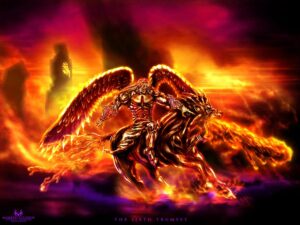
“Then the sixth angel sounded: And I heard a voice from the four horns of the golden altar which is before God, saying to the sixth angel who had the trumpet, “Release the four angels who are bound at the great river Euphrates.” So the four angels, who had been prepared for the hour and day and month and year, were released to kill a third of mankind.
Now the number of the army of the horsemen was two hundred million; I heard the number of them. And thus, I saw the horses in the vision:
Those who sat on them had fiery red, hyacinth blue, and sulfur yellow; and the heads of the horses were like the heads of lions; and out of their mouths came fire, smoke, and brimstone. By these three blows a third of mankind was killed – by the fire and the smoke and the brimstone which came out of their mouths. For their power is in their mouth and in their tails; for their tails are like serpents, having heads; and with them they do harm.
But the rest of mankind, who were not killed by these wounds, did not repent of the works of their hands, that they should not worship demons, idols of gold, silver, brass, stone, and wood, which can neither see nor hear nor walk. And they did not repent of their murders or their sorceries or their sexual immorality or their thefts.” ~ Rev 9:13-21
Here we have another lengthier and more detailed prophesy to unpack: “Then the sixth angel sounded: And I heard a voice from the four horns of the golden altar which is before God…” – Again, the golden altar is mentioned, that is the incense altar, this time including its four horns from its foursquare corners; And, again, from this place of sanctuary goes forth the wrath of God. Details like this are designed to communicate something of significance:
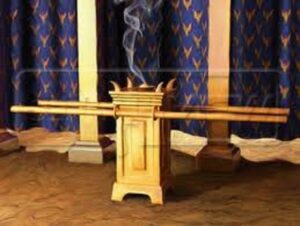 The golden incense altar represents the interceding atonement of the high priest (Num 16:44-48), which includes the intercessory prayers of His people, represented by rising smoke of incense (Psalm 141:2, Rev 5:8), resulting with the interceding provision of mercy wrought by the high priest – ultimately fulfilled by Jesus Christ (Heb 4:14-16).
The golden incense altar represents the interceding atonement of the high priest (Num 16:44-48), which includes the intercessory prayers of His people, represented by rising smoke of incense (Psalm 141:2, Rev 5:8), resulting with the interceding provision of mercy wrought by the high priest – ultimately fulfilled by Jesus Christ (Heb 4:14-16).
This holy article, signifying mercy & grace, set inside the house of God, had its counterpart just outside the house; that is the bronze alter – much larger for the burnt offerings, yet also having four horns upon its foursquare corners. Being the most sacred object outside the house, this holy article was sometimes misused in the past with the superstitious idea which presumed to seek refuge by merely claiming the altar, sometimes even grabbing hold of the horns of the altar, to be pardoned of guilt (1 Kings 1:50-51). There was a notion which treated the altar as if it were some kind of magical get-out-of-jail-free-card. However, the only refuge granted by God to those guilty of bloodshed was in the event of accidental killing (manslaughter – Num 35:9-34).
Yet people like Joab, who was guilty of premeditated murder, presumed to seek refuge by grabbing hold the horns of the altar; King Solomon then defied this pop-superstition by having Joab slain there at the altar (1 Kings 2:28-34), according to Exodus 21:14, which says. “But if a man acts with premeditation against his neighbor, to kill him by treachery, you shall take him from my alter, that he may die.”
Another point to remember: the priestly ministry of the altar was the exclusive business of the Levite priests from the line of Aaron. The scriptures repeat – the outsiders who comes near shall be put to death (Num 1:51, 3:10, 3:38, 18:7). That outsider was not just referring to Gentiles, but to any other Israelites (Num 18:22) who were not the descendants of Aaron. Even Levites from different families were not to come near as performing priests, nor lay hands on the temple furnishings (Num 4:15, 16:40).
Now, in the current dispensation of the New Testament, all those of genuine faith, who truly abide in Christ, are made priests and kings (Rev 1:6, 5:10, 20:6), whose business it is to enter the sanctuary of God, even the most holy place, to come before the throne of grace (Ephesians 2:12-13, Hebrews 4:16).
Yet, just like before, when outsiders presumed to the lay hands on the articles of the temple, so it was that outsiders presumed to lay hands on the New Testament Temple, that is the congregation of God (aka Church), with the notion that merely laying claim to the altar of the cross of Christ would be all that’s needed to receive the mercy & grace of God. To be clear, an outsider would be one who does not truly abide in Christ with genuine faith, but gives pretense to faith, using the Christian religion for wealth, power, and prestige.
Psalm 50: 16-21:
To the wicked God says,
“What right have you to tell of My statutes
And to take My covenant in your mouth?
“For you hate discipline,
And you cast My words behind you.
“When you see a thief, you are pleased with him,
And you associate with adulterers.
“You let your mouth loose in evil
And your tongue frames deceit.
“You sit and speak against your brother;
You slander your own mother’s son.
“These things you have done and I kept silence;
You thought that I was just like you;
I will reprove you and state the case in order before your eyes.”
With such a divine declaration against holy pretense in mind, we now continue with the sounding of the sixth angel – a voice from the four horns of the golden altar which is before God, – saying to the sixth angel who had the trumpet, “Release the four angels who are bound at the great river Euphrates.”
Again, there are certain principalities rendered here as angels, ambiguously described, leaving a degree of uncertainty to their exact identity. This time – four angels – who are bound at the great river Eurphrates – are to be released – on the premise of the profane use of all four horns of the golden altar, a symbolic illustration of the widespread misuse & abuse of ecclesiastical authority; These four angels providentially released to see to it that the outsiders who comes near shall be put to death.
These entities from the east are represented as angels for their power and strength to serve as the divine rod of wrath. The most prominent center near the Eurphrates river at the time of the mid-seventh century was Baghdad, the center of the Arab Caliphate. At that time and place there was great internal conflicts regarding the succession of Caliph. Such conflict bound the progress of their war campaign for a time.
“So the four angels, who had been prepared for the hour and day and month and year, were released…” (Upon resolving their internal disputes, they were released to resume their conquests abroad, according to the certain time frame allowed by divine providence) “…to kill a third of mankind …” (referring to the third part of the world – that is the Roman world).
“Now the number of the army of the horsemen was two hundred million; I heard the number of them.” The number in the original language is literally myriads of myriads, which could mean a specific number like two hundred million, but more likely expresses an immeasurable number. Such vast armies distinguished as horsemen indicates this being the second wave of the Arab invaders.
“And thus, I saw the horses in the vision: Those who sat on them had fiery red, hyacinth blue, and sulfur yellow…” (The colors of fire, smoke & brimstone – the terror of their appearance representing the fiery wrath of God); “…and the heads of the horses were like the heads of lions (Again, they are likened to lions which denote to their devouring nature); and out of their mouths came fire, smoke, and brimstone.” (Repetition of the same elements in different words serves to emphasize divine wrath expressed here in figurative prophesy style; This may also refer to the literal use of the flaming spear called the Fatarica).
“By these three blows (blows – often translated as plagues, but in the original – a blow, or wound) a third of mankind was killed (inflicting the Roman World) – by the fire and the smoke and the brimstone which came out of their mouths.” These three elements do not need to be forced into a literal fulfillment as we consider the symbolic imagery of prophesy language, but we should consider the meaning of each symbol since they are listed as the three elements by which a third of mankind was killed.
– the fire (typically used as a symbol of God’s wrath) – the smoke (we already observed in the fourth trumpet the billowing smoke from the bottomless pit representing loss of clarity due to corruption, as well as divine judgment) – and the brimstone (another symbol of divine wrath, and brimstone intermingled with fire, was literally the means of destruction upon Sodom & Gomorrah).
“For their power is in their mouth and in their tails; for their tails are like serpents, having heads; and with them they do harm.” Another figurative element from the prior prophesy of a scorpion-like creature with pinchers & mandibles at the head with a poison stinger at its tail. A fit illustration of such strange & daunting invaders. These repeating elements which correspond with the prior prophesy of the fifth trumpet gives credence to these warriors being the same Muslim Arabs as before.
Upon being providentially released from the bonds of their internal disputes, the Arab forces resumed their conquest throughout the Roman world, penetrating to the far western side to Spain by 713. With remarkable speed, they succeeded complete victory over key cities, crushed the ruling Visogoths into oblivion, and over-ran the entire country. The devastation has been described in the most horrid scenes of women & children brutally ravished, bodies strewn across the land, numerous buildings including church structures profaned & burnt, as the people became totally powerless to defend themselves.
Soon after, the Arab forces passed into France, continuing the same manner of devastation for some time, but were decisively beaten by Charles Martel in the Battle of Tours by 732. As already mentioned from the previous prophesy, Charles Martel was the providential instrument God used to preserve the true saints of God, as key regions of France became the land of the most notable representatives of the remnant church of the Middle Ages, known as the Waldensians and Abigensians. Such providential care saw to it that the four angels representing the Arab forces, once released, would only carry-on their destruction for the hour and day and month and year permitted by God.
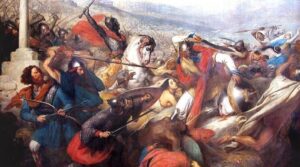
The final part of the sixth trumpet prophesy refers to the surviving populous of the corrupt Roman Church:
“But the rest of mankind, who were not killed by these wounds, did not repent of the works of their hands, that they did not stop worshiping demons, idols of gold, silver, brass, stone, and wood, which can neither see nor hear nor walk. And they did not repent of their murders or their sorceries or their sexual immorality or their thefts.”
An interesting detail that Lowman highlights is the religious reform initiated by Byzantine Emperor, Leo III, who was deeply concerned of the idolatrous practices throughout the battered empire. He recognized such pagan practices of worshiping patron saints, angels, and images – was validating the Muslim forces to carry out their conquests as God’s rod of reproof. However, such reform was not well received by the Latin Church of Rome. Pope Gregory II, with heated obstinance, issued a synod which confirmed the worship of images, and rejected the order from the emperor, and pulled power-plays against Leo III by excommunicating him and forbidding Italy to pay taxes and homage to the emperor.
Such a spirit of obstinacy continued with succeeding popes who led both western and eastern society that they did not stop worshiping demons, which spirits were behind every kind of idol. As the Apostle Paul said, “What do I mean then? That a thing sacrificed to idols is anything, or that an idol is anything? No, but I say that the things which the Gentiles sacrifice, they sacrifice to demons and not to God; and I do not want you to become sharers in demons.” (1st Corinthians 10:19-20). Such insidious spirits woven within idolatry naturally opens the gateway for other corruptions like murders, sorceries, sexual immorality, thefts.
And it was this elevated level of corruption which carried into the next period of prophetic history, which set the climate for a much higher degree of misuse & abuse of the Christian religion. Such a gall of bitterness & wormwood would crop up so heavily during this period to produce the worst kind of abomination. This next segment of prophesy, revealed in the little book, is an extension of the sixth trumpet, which pertains to a period of time of the most significant events.
So important is this time period of the little book, that the Spirit of prophesy dedicated a large portion of The Revelation to it – giving three different representations of the same period in chapters 11-13, and prophesy of God’s wrath upon the persecuting power of this period in chapters 14-16, the interpretation of the persecuting power in chapters 17-18, and the final destruction of the persecuting power in chapter 19. And, besides this book of prophesy, several chapters of Daniel pertain to this same period of time.
Now we will conclude this part of The Seven Trumpets with the introduction of the little book:
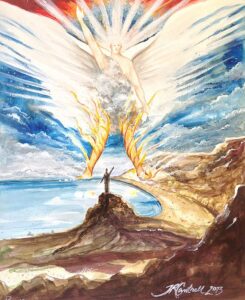
“I saw still another mighty angel coming down from heaven, clothed with a cloud. And a rainbow was on his head, his face was like the sun, and his feet like pillars of fire. He had a little book open in his hand.
And he set his right foot on the sea and his left foot on the land, and cried with a loud voice, as when a lion roars. When he cried out, seven thunders uttered their voices.” ~ Rev 10:1-3
St John’s vision of this angel is rendered with divine attributes, such as clothed with a cloud – rainbow on his head – face like the sun – feet like pillars of fire. This may seem like a high ranking created angel with divine-like qualities, but there are certain signs which indicate this is the Angel of the Lord – Jesus Christ. The description here is very similar to the first vision of Jesus Christ, which John records in this book in 1:14-16; Also, this same angel further instructs John in chapter 11 says, “And I will give power to my two witnesses…”, which indicates ownership and source of power, both of which belong solely to the LORD. John Gill interpreted feet like pillars of fire to represent the martyrs, who were burned at the stake, yet remained pillars of Christ’s Temple.
Besides the divine characteristics just mentioned, “He had a little book open in his hand…” – Remembering back to the prelude to the Seven Seals, when no one was found worthy to open and read the scroll, or to look at it – except – the Messiah. But rather than simply calling Him Messiah, one of the elders introduced Him by the messianic description title – The Lion of the Tribe of Judah – corresponding with this prophesy, and cried with a loud voice, as when a lion roars…
“And he set his right foot on the sea and his left foot on the land…” – This denotes His overarching dominion upon the earth.
“Now when the seven thunders uttered their voices, I was about to write; but I heard a voice from heaven saying to me, “Seal up the things which the seven thunders uttered, and do not write them.”” Apparently, this was a message only for the Apostle John, which would not be revealed to the church in general.
“The angel whom I saw standing on the sea and on the land raised up his hand to heaven and swore by Him who lives forever and ever, who created heaven and the things in it, the earth and the things that are in it, and the sea and the things that are in it, that there should be delay no longer, but in the days of the sounding of the seventh angel, when he is about to sound, the mystery of God would be finished, as He declared to His servants the prophets.” ~ Rev 10:5-7
The Angel of the LORD projects a solemn and resolute announcement regarding the time of the seventh trumpet, which will mark the completion of the mystery of God; That is to say, the mystery of prophesy becoming fully revealed and clarified upon the completion of prophetic history. The nature of prophesy is vague and obscure until its fulfillment, so the complete fulfillment of prophesy upon the end of the current era will reveal the full meaning of all prophesy pertaining to this epoch.
“Then the voice which I heard from heaven spoke to me again and said, “Go, take the little book which is open in the hand of the angel who stands on the sea and on the earth.”
So I went to the angel and said to him, “Give me the little book.” And he said to me, “Take and eat it; and it will make your stomach bitter, but will be as sweet as honey in your mouth”
Then I took the little book out of the angel’s hand and ate it, and it was as sweet as honey in my mouth. But when I had eaten it, my stomach became bitter. And he said to me, “You must prophesy again about many peoples, nations, tongues, and kings.” ~ Rev 10:8-11
The idea of eating the little book is clarified by referring to prior scriptures which speak of God’s word as spiritual food – man shall not live by bread alone, but by every word that proceeds from the mouth of the LORD (Deut 8:3). Jesus quoted that same verse against the temptation of Satan, and also said another time, “My food is to do the will of Him who sent me…” (John 4:34). Also, Jeremiah 15:15, “Your words were found, and I ate them, And Your word was to me the joy and rejoicing of my heart; For I am called by Your name, O LORD God of hosts.”; and Ezekiel 3:1-3, all of which collectively illustrates how the Word of God is to be internalized.
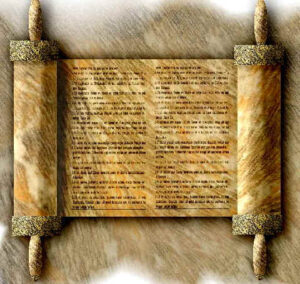
Now St. John ate the little book, which was not just the word of God in general, but a very particular episode of prophesy which was both exciting and disturbing to see. So it was, that the revelation was thrilling to see at first, “sweet as honey in my mouth”, but after swallowing & digesting the full meaning and contemplating the ramifications, it was upsetting to his soul, as his stomach became bitter.
According to the content of the little book, the Apostle John is commissioned to prophesy further – “You must prophesy again about many peoples, nations, tongues, and kings.”
From this point, the time period of this further prophesy of the little book, being an extension of the sixth trumpet, opens a whole new segment of prophesy into the next period of time, which is represented in three different ways: First, the two witnesses of chapter 11; Second, the woman flying into the wilderness of chapter 12, Third, the two beasts of chapter 13. These three renderings illustrate the plight of the remnant church in perilous times under the persecuting power. Moreover, chapters 14-16 reveal God’s wrath upon the persecuting power; Chapter 17-18 cover the interpretation of the persecuting power; And chapter 19 reveals the final destruction of the persecuting power.
So significant is this episode of prophetic history that half the content of things which were to take place after St. John’s Revelation were dedicated to this period. In this part of the Revelation, the duration of this time period is revealed, the circumstances of the Christian religion is revealed, the circumstances of the true saints of God is revealed, the blasphemous persecuting power is revealed, and God’s retribution upon that power is revealed; All these things revealed in this next segment of prophesy from the little book, which precedes the second coming of Jesus Christ upon the sounding of the seventh trumpet.
We will conclude this part of The Seven Trumpets here and continue the next part with The Two Witnesses.
Main Sources
– Word & Spirit of God, Who Was and Is and Is to come
– The Apostolic Fathers – The Researchers Library of Ancient Texts Volume 2
– Saint Augustine – “City of God”
– Moses Lowman – “Paraphrases and Notes on the Revelation of St. John“
– John Clark Ridpath – ‘Ridpath’s Universal History’
– Charles Daubuz – “A Perpetual Commentary on the Revelation of St. John“
– E H Broadbent – “The Pilgrim Church”
– Thomas Newton – “Dissertations of the Prophesies” – Volumes 1-3
– Henry Fliedner – ‘The Martyrdom of a People’ or ‘The Vaudois of Piedmont and Their History‘
– John Gill – “Gill’s Exposition of the Bible“
– Sir Isaac Newton “Daniel and the Apocalypse”
– Peter DeRosa – ‘Vicars of Christ: ‘The Dark Side of The Papacy’
– Joseph Benson – “Benson’s Commentary on Revelation“
– Charles Spurgeon – Spurgeon Archive
– Adam Clark – “Clark’s Commentary on the Bible“
– Augustus Toplady – ‘The Road To Rome’
– John Foxe – ‘Foxes Book of Martyrs’
– Albert Barnes – “Barnes’ Notes on the Entire Bible
– Kenneth Scott Latourette – ‘A History of Christianity’

